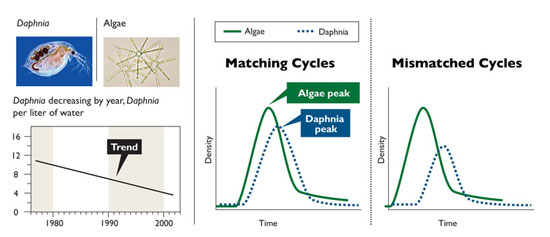By Erica Goldman
In some ecosystems, food webs have already shown obvious signs of rising global temperatures. In Seattle's Lake Washington, for example, scientists identified an "uncoupling" of the link between algae (phytoplankton) and the tiny animals that graze on them (zooplankton) that can be traced directly to climate warming. Limnologists Monika Winder and Daniel Schindler at the University of Washington used a historical data set to identify a mismatch between the timing of the spring phytoplankton bloom and a key zooplankton grazer, publishing their results in a 2004 paper in the journal Ecology.
Since 1962, increasingly warmer springs in the region advanced the timing of the seasonal phytoplankton bloom by 20 days, explains Winder, who is now a research scientist at the Tahoe Environmental Research Center in Davis, California. As a result, the water flea Daphnia, a keystone grazer in the system, experienced a long-term decline that may have severe consequences for upper levels in the food chain — like fish.
Other zooplankton species in Lake Washington, however, seem to have adapted better to the early onset of spring warming, says Winder. One grazer (the rotifer Keratella) shifted its peak densities 21 days earlier to correspond with new peak timing of the phytoplankton population. Another zooplankton species in the lake, a copepod, cut its generation time in half, so that it fits a whole additional reproductive cycle into the longer growing period.
For predator and prey, who eats what when is very important, says Winder. But the mechanisms that allow some species to adapt to such shifts in climate better than others are still poorly understood, she says. Moreover, the effects higher up on the food chain are still very hard to quantify.
If the food web impacts of climate warming are difficult to account for in an ecosystem like Lake Washington, they are that much harder in a place like the Chesapeake Bay. Unlike the Bay, Lake Washington is relatively unpolluted and has been stable and free from nutrient overloading (eutrophication) since the 1970s. In the Bay, the impacts of nutrient pollution and hypoxia on species distribution interactions can be dramatic, potentially masking the effects of climate, says Kimmel.
Additionally, since estuaries experience far more seasonal climate variability as a result of freshwater flow than lakes do, many species in the Bay are adapted to the "ephemeral nature" of an estuary and a wide range of temperatures, explains Tom Miller, a fisheries biologist at the UMCES Chesapeake Biological Laboratory in Solomons Island, Maryland. "Species that make their living in estuaries need to be able to respond to that variability," he says. "But global climate change will certainly be a factor, because the one thing that species do respond to are changes in minimum and maximum temperatures."

|
Declining Food Source in
|
|

Graphicreprinted, with permission, from the Seattle Post-Intelligencer. Data Sources: University of Washington scientists Monika Winder, Michael Brett, Dave Beauchamp,Tommy Edmondson,Arni Litt, Daniel Schindler; Sally Abella, King County; Dave Seiler, Washington Department of Fish and Wildlife; Intergovernmental Panel on Climate Change. |
||
![[Maryland Sea Grant]](/GIFs/h_footer_mdsg.gif)